Member Profiles
27th May 2024
Our latest profiles explore the working lives of Sheona Shankland and her use of biology to discover the past; Dr Ivan Yow Ying Ming and his move from education to research; and Jordon K Millward's quest to improve science communication.
A DAY IN THE LIFE
Sheona Shankland MRSB is a PhD researcher at the University of Lancaster investigating the bone chemistry of ageing and disease.

My alarm goes off...
And I head straight for the coffee before cycling to university.
My work involves…
Bones and lasers! Most of my samples are archaeological, from the sailors of Henry VIII’s Mary Rose and from the medieval mass grave at Thornton Abbey. I use modern clinical samples too, from Manchester Children’s Hospital. I analyse the chemistry of these samples using Raman spectroscopy, which is non-destructive and allows the sample’s biochemical fingerprint to be determined. My work focuses on bone mineral, and protein if possible, aiming to understand more about the chemistry of ageing and the application of this knowledge to modern science and medicine.
On a typical day…
I’m in the Raman lab, measuring the chemistry of archaeological vertebrae or clavicles, or surgically extracted bone cores. I sometimes deliver anatomy teaching in the medical school too.
Right now I am…
Adapting my PhD research on the sailors of the Mary Rose to create an exhibit for the Mary Rose Museum. Outreach and science communication are important to me, so I am excited to disseminate my PhD research in a way that the public can interact with, learn from and enjoy through digital models and 3D-printed bones.
I work with…
My amazing supervisors Dr Jemma Kerns and Professor Adam Taylor, and the wonderful teams at the Mary Rose Museum, The Thornton Abbey Project, and Manchester Children’s Hospital. I am lucky to have access to such historically important samples and cool equipment.
I also….
Teach anatomy and am on the Anatomical Society council. I was a prosector (someone who dissects cadavers for anatomical research and teaching) at the universities of Glasgow and Liverpool before coming to Lancaster, and I taught students from various disciplines. I am also an assistant osteoarchaeologist at the Poulton Research Project; I help run field schools in the medieval cemetery, teaching students how to excavate burials.
After work…
I am usually writing, at a gym class, or at a pub quiz. At the weekends I often go wild swimming in the Lake District or visit my family and friends back in Glasgow for some gigs and dog walks.
In the future…
I’m looking forward to finding a role that will allow me to use my research and science communication skills.
THE CAREER LADDER
Dr Ivan Yow Ying Ming MRSB is the Eric and Wendy Schmidt AI in Science postdoctoral fellow at the Mechanobiology Institute, National University of Singapore.

I first discovered biology…
At the age of 15 at high school. My passion for the subject was reignited during my second year of undergraduate studies at the National University of Singapore (NUS) where I had the privilege to be able to delve into functional genomics. It gave me a unique perspective on how our contributions in this field can make a significant impact on the biomedical scene.
I studied…
Life sciences with a focus on molecular and cell biology at the NUS. Following this, I completed the Postgraduate Diploma in Education programme at the National Institute of Education, Nanyang Technological University (NIE/NTU). I also pursued two concurrent master’s degrees in applied physics (at NIE/NTU) and education leadership and management (at The Open University, UK). Later I returned to the NUS to embark on a PhD in mechanobiology, and to complement my journey as a technopreneur, I recently completed an executive Master of Business Administration from the Quantic School of Business and Technology.
I always knew…
That my calling lay in education. The joy of interacting with students and being able to guide them on their path has always been a source of immense fulfilment for me.
A pivotal point in my career was…
When I decided to embark on a transformative journey as a PhD candidate in mechanobiology. Delving into a very specific topic was both exciting and intellectually stimulating. Though the transition from teaching to research was a significant leap, I am now more convinced than ever that I made the right choice.
The best thing about my job is…
Aligning my passions for education, research and science in one role.
This is an interesting area to work in because…
It allows me to interact with experts from both the research and business domains. I am currently spearheading several industrial projects focused on translating mechanobiology basic research into practical applications. These projects span diverse domains including cultured meat production, agriculture, and cell therapy.
Not many colleagues will know…
I am an avid gamer and karaoke singer. I am well-versed in basketball, badminton, table tennis and middle-distance running.
In the future, I hope to…
Expand my mentorship and advisory role into other countries.
MY SOCIETY AND ME
Jordon K Millward MRSB is a doctoral research student at Imperial College.

I joined the RSB in 2021 through my university’s Membership Accreditation and Recognition Scheme. I have since attended meetings with my local branch to forge a better connection with scientists local to me, as well as establishing links for schools to support science across the region. I also aim to propose and develop events with the London branch in collaboration with my university.
Being a member of the RSB has given me a better and broader connection with STEM. It has allowed me to continue to share academic updates with a wider audience as I aim to grow the representation of science within different mediums. As someone passionate about science communication, it has enabled me to connect with different scientists and plan larger events to share scientific discoveries with the next generation of scientists and improve representation.


